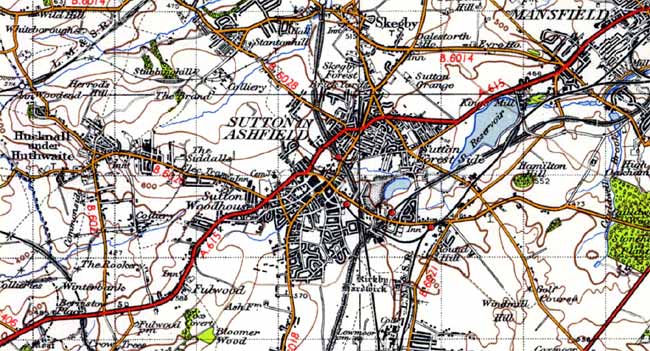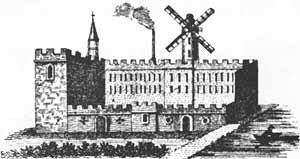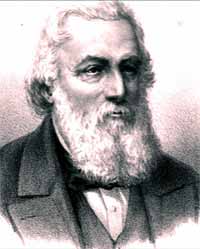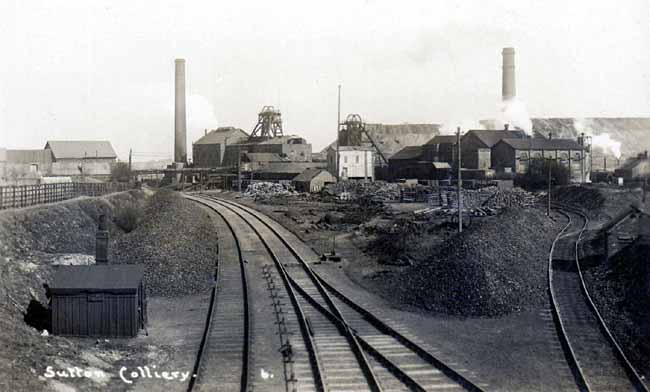

Sutton-in-Ashfield in 1947.
The large historic parish of Sutton-in-Ashfield covered an area of 5,861 acres (2,312 ha) and comprised the townships of Sutton-in-Ashfield and Hucknall under Huthwaite. Under the Local Government Act of 1894 both Sutton-in-Ashfield and Huthwaite formed Urban District Councils; in 1934 Huthwaite UDC was abolished and Huthwaite (along with the parishes of Teversal and Skegby) was transferred to the urban district of Sutton-in-Ashfield.
Ashfield District Council was formed in 1974. Sutton, with a population of over 49,000 people, is the largest town in the district.
Early history
The most significant prehistoric monument is Hamilton Hill, to the east of the town centre, that is surmounted by ‘an earthwork consisting of an irregular D-shaped quarry hollow with an elliptical mound towards the east end.’ Once thought to be a Bronze Age barrow but this interpretation is now doubtful. One current suggestion is that ‘the earthwork was a purpose-designed arena, either for means of entertainment or as a place of assembly.’
In 1930 a Roman coin of Gaius Claudius Pulcher, who was consul in 177 BC, was found in Bathwood Drive and a hoard of over 300 Roman silver coins was found near King’s Mill during railway construction in 1849. Field-walking near Hamilton Hill in advance of road-building in the late 1990s uncovered a scatter of Romano-British pottery and heat-affected stones which may indicate a Romano-British settlement site.
Domesday Book (1086) records that Sutone and Schegebi (Skegby) were outliers of the manor of Mansfield, which belonged to the king. The entry for the manor of Mansfield mentions two churches and it is likely that one of them was at Sutton. Sutton church was given to Thurgarton Priory in around 1189 by Gerard, son of Walter de Sutton and the earliest fabric in the building dates from the 12th century.
From the 12th to the 15th century the de Sutton family held the manor of Sutton from the king.
Little is known about the layout of the village before the early 17th century but there was at least one village green as a list of tenants of the manor of Mansfield here in 1295 includes two who have the epithet ‘on the Green.’
17th to 18th centuries
William Senior’s map of Sutton, surveyed in 1610, shows the straggling village surrounded by large common fields (East Field, West Field, South Field, Kirke Field and Little Field) and a patchwork of enclosed fields. The process of enclosure clearly continued, since in 1790 John Throsby was able to describe Sutton as being 'chiefly enclosed', and four years later an Act of Parliament was obtained for the enclosure of the remainder, the Award being in 1810.
Religious dissent in Sutton and the area was an issue for the established church in the 17th and 18th centuries. The Compton Census of 1676 recorded that there were 194 communicants in Sutton-in-Ashfield, no Roman Catholics and 32 dissenters. An Independent congregation (later known as the Congregationalists and more recently the United Reform Church) formed in the village during the 1650s. At Archbishop Drummond’s visitation in 1764 the curate of Sutton parish church reported that there were in the parish ‘341 families of these sixty are a mixture of Independents and Presbyterians, the other ten Methodists.’ He added that ‘There [are] two licenced meting houses. One for the Independents and Presbyterians, the other for the Methodists.’
The 1674 Hearth Tax return lists 62 households in Sutton-in-Ashfield, a smaller number than neighbouring Mansfield (318 households) and Kirkby-in-Ashfield (74). ‘Hucknall Chaworth’ (Huthwaite) contained 32 households.

Unwin’s Mill c.1790 showing simultaneous use of water, wind and steam power.
References to stocking frames in wills suggest that the framework knitting industry was well established in Sutton by the end of the 17th century: for example, in 1675 Anne Clay left four silk stocking frames to her son. By 1727 there were 40 stocking frames in Sutton and in order to supply yarn to the framework knitters a horse-powered cotton spinning mill (Sutton Old Mill) was erected by Samuel Unwin at East Side in 1740. Thirty years later his son, Samuel, rebuilt the mill at a cost of £6,000 into an imposing four-storey building with a castellated Gothic façade that incorporated Richard Arkwright’s newly patented water frame to carry out cotton doubling (twisting together strands of cotton to create a strong yarn). The horses were replaced by a 24-foot water-wheel but the water supply from the 8½ acre reservoir was inadequate at certain times of the year so in 1771 a wind-mill was added and in 1789 a Newcomen steam engine was installed to pump back water into the reservoir. The mill, therefore, ‘used water, wind and steam power simultaneously, a unique feature at the period, at any rate in the English midlands.’ Unwin’s mill is considered historically important as it was ‘probably the first to emulate Arkwright’s method of factory cotton-spinning.’
Samuel Unwin I built Sutton Hall, a handsome stone Georgian mansion in the early 1750s. It was located at the southern end of the mill reservoir and a few years later had a spacious park with plantations and gardens.
19th century
On 13 November, 1811, Luddite rioters marched from Arnold to Sutton-in-Ashfield. Their main target was the hosier, Francis Betts, and after confronting him at his house, they proceeded to search out and destroy all his frames and between 40-70 frames were smashed that night. The Luddites met some resistance from the Mansfield militia and a handful of dismounted Dragoons caught some of the rioters and scared away the rest.
White’s Directory of Nottinghamshire published in 1832 provides a succinct summary of the village at that time:
‘Sutton-in-Ashfield, 3½ miles W. S. W. of Mansfield, is a very large village and township, comprising more than four-fifths of the parish, and 4805 inhabitants, mostly employed in the cotton, hosiery, and lace manufactures, there being here no fewer than 1700 stocking frames, 20 bobbin net machines, and an extensive factory for spinning cotton, and making checks and nankeens. Here are likewise two potteries of coarse red ware.’

Spencer Timothy Hall.
A once famous native of Sutton-in-Ashfield was Spencer Timothy Hall (1812-1885) described as an ‘English writer and mesmerist.’ He was born into poverty but aged 16 ran away to Nottingham and started work for a newspaper. He learned printing, married and returned to Sutton to become the postmaster and established a small printing press. He printed a monthly periodical called the Sherwood Magazine, in which he published his work under the pseudonym ‘The Sherwood Forester’. Other books and poetry followed. Hall was also interested in popular scientific movements, such as phrenology and mesmerism. In 1852 he set himself up as a homeopathic doctor in Derby but although he called himself ‘Doctor’ he was not qualified and failed to make a living from it. Arthur Mee described him as the ‘amazing Spencer Timothy Hall, who could plough and reap, stack and thresh and winnow, make a stocking and a shoe, write a book and print and bind it, and cure all sorts of ills. Perhaps the most astonishing Jack of all Trades of his day, he sleeps at Blackpool, but he is still known as the Sherwood Forester, and will long be remembered here.’
Over the course of the 19th century, however, Sutton would see dramatic changes: the arrival of the railways, the expansion of the textile industry and the exploitation of the concealed coalfield. This would lead to a dramatic increase in population: 2,801 inhabitants in 1801, 6,542 in 1851 and 14,866 in 1901.
The earliest railway in the area was the Mansfield to Pinxton line which was developed by the colliery owners of the Erewash valley to access markets for coal around Mansfield. It opened in 1819 and in 1847 the Midland Railway acquired the line and opened a station on Forest Lane in 1849. In 1893 the station was renamed Sutton Junction after the Midland Railway built a branch line (1.2 km long) that terminated at a railway station on Forest Street (later Station Street) known as Sutton Town and later as Sutton-in-Ashfield General.
In 1898 the Great Northern Railway opened a line through Sutton that linked Nottingham with Langwith and built a station in Outram Street. It was originally called Sutton-in-Ashfield for Huthwaite but was later renamed Sutton-in-Ashfield Town. In 1910 construction started on the Mansfield Railway, a 11-mile route between junctions at Kirkby and Clipstone, commissioned by local colliery owners. The line opened in April 1917 and one of the new stations on the line was Sutton-in-Ashfield Central on Station Road. The railway was operated by the Great Central Railway.
The textile industry continued to develop through the 19th century, a cotton mill was built at Idlewells and in the 1880s a cotton doubling works was located on Oddicroft Lane. I. & R. Morley took over the hosiery factory on Penn Street (opened in May 1880 by the Midland Hosiery Company) in 1887. A list of principal industries in the town published in 1907 included nine other hosiery and textile companies. In total there were 1,800 people employed in the industry in Sutton at this time.
 Sutton Colliery, c.1910.
Sutton Colliery, c.1910.The development of the concealed coalfield around Sutton started in the late 1860s and several collieries were established around the town: Teversal (also known as ‘Butcherwood’) was sunk in 1868, Sutton (also known as ‘Brierley Hill’) in 1873, Silverhill in 1875, New Hucknall in 1876-9 and Kirkby (‘Summit’) in 1887. As a result, coal mining became an increasingly important source of employment in the area. In 1907 there were around 5,450 people working at the local collieries.
Until the mid-19th century the village was governed by the vestry but in 1866 a Local Board of 15 members was established and in 1894 an urban district council was created. The second half of the 19th century also saw the provision of a gas supply (1852) and piped water from a reservoir on Coxmoor Hill was available from 1886.
A satellite settlement developed to the east of the town in the 19th century in an area known as Forest Side (also called Eastfield Side). By the 1870s it contained about 1,500 inhabitants who worked as framework knitters, colliers, textile hands. Two potteries manufacturing garden pottery and glazed earthenware were also in operation here.
20th to 21st centuries
In 1905 properties on the west side of the market place were demolished to create a square-shaped area. The same year a tram service was introduced by the Mansfield and District Light Railway Company Ltd between Mansfield and Huthwaite that ran through Sutton. It was discontinued in 1932.
During the Second World War the community of Sutton-in-Ashfield raised £161,000 of £200,000 in 'Warship Week', to build a new warship HMS Belvoir, which was adopted by the town in 1942. In 1940, they raised money for a Royal Air Force Spitfire fighter plane named the 'Silver Sniper'.
The site now occupied by Kings Mill Hospital was originally the 30th General Hospital of the University of California, established in 1942 to serve as a military hospital for the United States Army. During the Second World War it treated over 400 injured U.S. servicemen as well as housing German prisoners of war.
A guide to Nottinghamshire published c.1962 reported that the main industry in Sutton-in-Ashfield ‘is coal mining, but a large proportion of the population is also engaged in the manufacture of hosiery, plastics, light engineering, etc. while lime is manufactured from the limestone quarried in the district.’
Pretty Polly, one of the leading manufacturers of stockings, knitwear and lingerie in the country, was established here in the 1920s. After the Second World War the company had a sprawling factory with around 1,000 employees on Unwin Road but in 2005 production was moved to Belper in Derbyshire and the factory in Sutton was closed and demolished.
Since the 1960s the town has suffered the decline of its traditional industries with the closure of all the collieries, most of the textile factories and all four of its railway stations.
The most significant changes in the built environment were the building of the Sutton Centre behind the market place on High Pavement designed to provide educational and recreational facilities for the town and the Idlewells Shopping Centre constructed in the 1970s, which contained shops, offices, car parks, banqueting suites and a public library.
In 1995 a rail service for Sutton was re-established when the Robin Hood Line between Nottingham and Worksop was constructed. The project included the building of Sutton Parkway station, located on the eastern side of the town.
The retail sector, public sector and distribution now form the main sources of employment in the area.